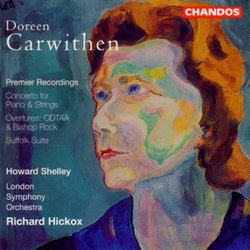A Composer Worth Our Attention
J Scott Morrison | Middlebury VT, USA | 12/07/2003
(5 out of 5 stars)
"Bursting from a cocoon of silence after as much as 50 years, the music of Doreen Carwithen spreads its wings like a beautiful butterfly on this Chandos release. Like many women composers, her music was ignored, by and large, at least in the concert world and Carwithen made her living writing music for over thirty films before taking on, in the early 1960s, the job of amanuensis, secretary and, ultimately, wife of film composer William Alwyn, whose concert music has also begun to have a life of its own. Known by her married name, Mary Alwyn, she has spent much of her energy since his death in 1985 spreading the word about her husband's music and until this recording her own music has been kept very much in the background.With lifelike sound which is a credit to Chandos and performances that have the breath of life in them thanks to Hickox and the LSO, this recording contains the first piece of Carwithen's ever to be played in a major concert; it was premiered by Sir Adrian Boult and the London Philharmonic in 1947. The bounding opening measures of the overture, ODTAA ('One Damn Thing After Another'), inspired by John Masefield's novel, use a brash and breezy Waltonesque sound to bring us directly into the novel's sense of adventure. Later there is a quiet middle section that suggests the romance of the novel. The overture ends with an orchestral fanfare that remoulds the opening motif.The neoclassic piano concerto, the longest work at 29 minutes, is in three movements. The opening Allegro assai opens with spirited virtuosic writing for both piano and orchestra and after an extended cadenza broadens to a romantic treatment of both opening themes. The pensive second movement, Lento, opens with a long lyrical theme played by solo violin which then becomes an extended duet between violin and piano, over muted strings. At times the mood is rather like that of RVW's 'Lark Ascending'. The finale, Moderato e deciso ma con moto, has a striding opening theme that then contrasts with the chittering moto perpetuo writing for the solo piano. It ends with a fugato section that evolves into broadly chordal and incisively rhythmic writing that brings the concerto to a rousing finish. Howard Shelley, as would be expected, acquits himself brilliantly in the difficult piano part.The overture, Bishop Rock, attempts to picture the lighthouse and surrounding sea, stormy or gently lapping, of Bishop Rock, that furthest west of the Scilly Isles. The language is craggier, as befits the subject, and may represent some change in Carwithen's language some five years on from the previous two pieces.The Suffolk Suite, commissioned for the school orchestra at Framlingham College, uses tunes from an earlier film about East Anglia. It was written with the capabilities of the boys involved. One does not sense any 'writing down' here. The music is, however, somewhat more conventionally organized and harmonized than the preceding music. There are four sections: Prelude, Orford Ness, Suffolk Morris, and Framlingham Castle. Lovely tunes abound and the morris dance is particularly infectious.The disc, arranged in order of the music's dates of composition, is also cleverly arranged so that there is an extrovert beginning and ending, with rather craggier. reflective and astringent inner 'movements', the Concerto and Bishop Rock.It is certainly too brief an acquaintance for me to make any claims for Carwithen's aspirations to greatness, but she certainly has the goods. This is well-made, attractive, solid, engaging music and I'm eager to hear more.Bravo to those folks at Chandos for expanding our horizons.Scott Morrison"


 Track Listings (9) - Disc #1
Track Listings (9) - Disc #1